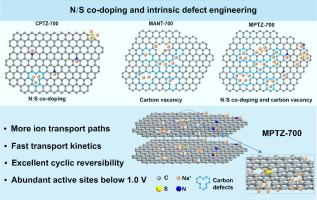Unveiling the role of intrinsic defects in N/S Co-Doped hard carbon for superior sodium-ion batteries
IF 13.3
1区 工程技术
Q1 ENGINEERING, CHEMICAL
引用次数: 0
Abstract
Hard carbon materials have emerged as a crucial anode choice for commercial sodium-ion batteries (SIBs), owing to their inherent abundance in porosity and the adaptability in adjusting interlayer spacing. However, the low capacity below 1 V and sluggish transportation kinetics respectively hinders the output voltage and rate performance. In this work, a one-step polymerization technique has been proposed to synthesize interconnected three-dimensional N/S-rich molecules via a methylene (–CH2-) bridge. During the subsequent carbonization process, the in-situ elimination of –CH2- bridge and partial heteroatoms facilitated the formation of intrinsic defects within the carbon layers, yielding an N/S co-doping hard carbon with intrinsic defect structures. This innovative approach provides a remarkable reversible capacity of 238mAh g−1 at voltages below 1 V, a high-rate capability of 150mAh g−1 at 5 A/g, along with exceptional cyclic stability of nearly 100 % capacity extension after 2000 cycles. This obviously enhancement in low-voltage sodium storage capacity and rate performance is attributed to the enhanced effect through N/S co-doping with intrinsic defect structures. This work highlights the critical role of defect engineering in carbon materials for efficient low-voltage sodium ions storage, offering a promising anode material with superior rate and cyclic stability.

揭示了N/S共掺杂硬碳在高性能钠离子电池中的内在缺陷作用
硬碳材料因其固有的丰富孔隙率和调整层间间距的适应性,已成为商用钠离子电池(SIB)的重要阳极选择。然而,1 V 以下的低容量和缓慢的传输动力学分别阻碍了输出电压和速率性能。本研究提出了一种一步聚合技术,通过亚甲基(-CH2-)桥合成富含 N/S 的三维分子。在随后的碳化过程中,-CH2-桥和部分杂原子的原位消除促进了碳层内部固有缺陷的形成,产生了具有固有缺陷结构的 N/S 共掺硬碳。这种创新方法在电压低于 1 V 时可提供 238mAh g-1 的显著可逆容量,在 5 A/g 时可提供 150mAh g-1 的高速容量,同时还具有优异的循环稳定性,在 2000 次循环后容量可延长近 100%。低压钠存储容量和速率性能的明显提升归功于 N/S 与固有缺陷结构共同掺杂所产生的增强效应。这项工作凸显了缺陷工程在碳材料高效低压钠离子存储中的关键作用,为具有卓越速率和循环稳定性的阳极材料提供了前景。
本文章由计算机程序翻译,如有差异,请以英文原文为准。
求助全文
约1分钟内获得全文
求助全文
来源期刊

Chemical Engineering Journal
工程技术-工程:化工
CiteScore
21.70
自引率
9.30%
发文量
6781
审稿时长
2.4 months
期刊介绍:
The Chemical Engineering Journal is an international research journal that invites contributions of original and novel fundamental research. It aims to provide an international platform for presenting original fundamental research, interpretative reviews, and discussions on new developments in chemical engineering. The journal welcomes papers that describe novel theory and its practical application, as well as those that demonstrate the transfer of techniques from other disciplines. It also welcomes reports on carefully conducted experimental work that is soundly interpreted. The main focus of the journal is on original and rigorous research results that have broad significance. The Catalysis section within the Chemical Engineering Journal focuses specifically on Experimental and Theoretical studies in the fields of heterogeneous catalysis, molecular catalysis, and biocatalysis. These studies have industrial impact on various sectors such as chemicals, energy, materials, foods, healthcare, and environmental protection.
 求助内容:
求助内容: 应助结果提醒方式:
应助结果提醒方式:


